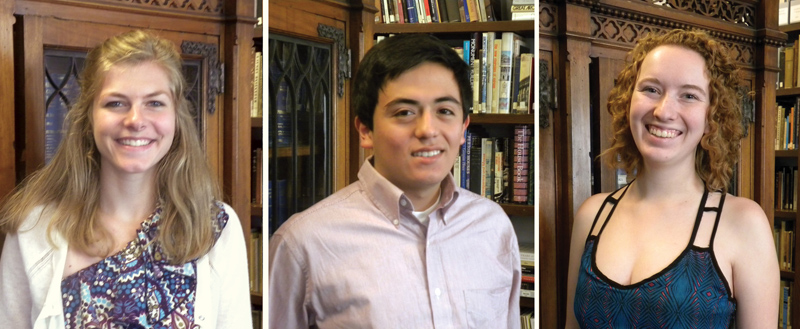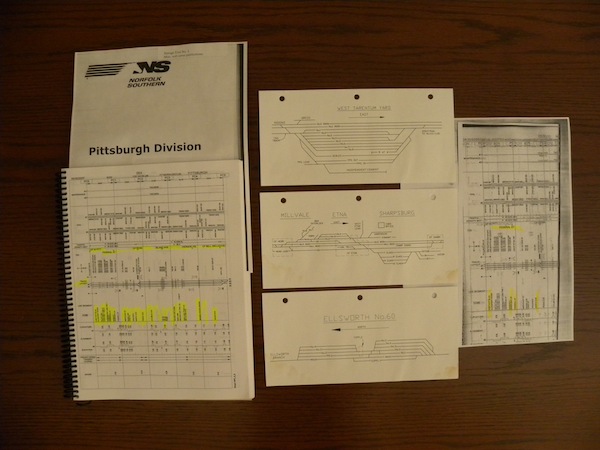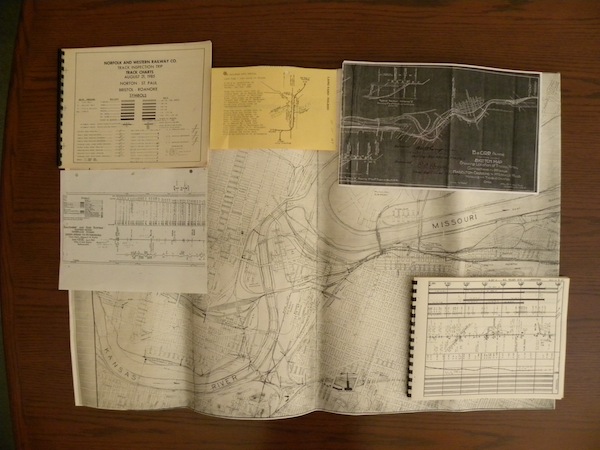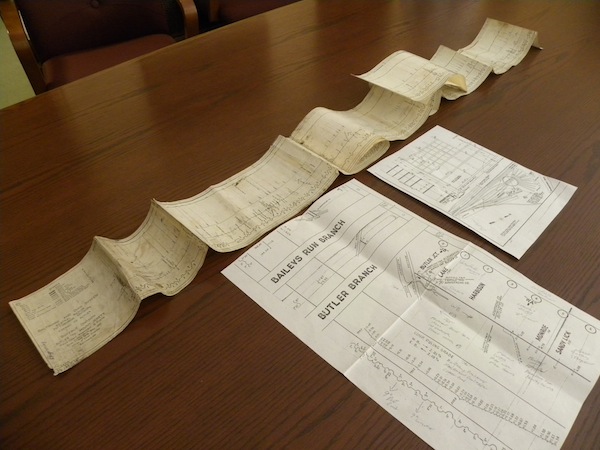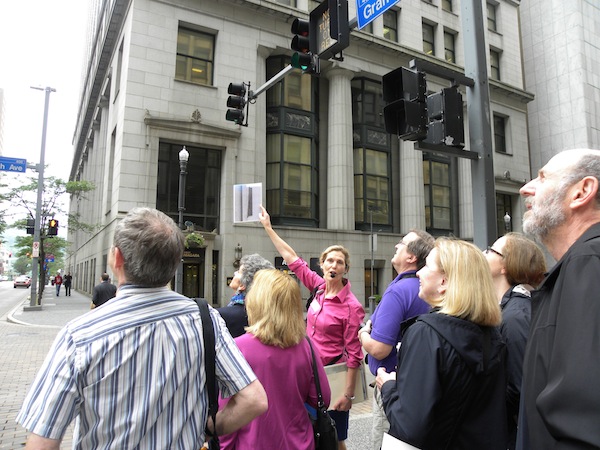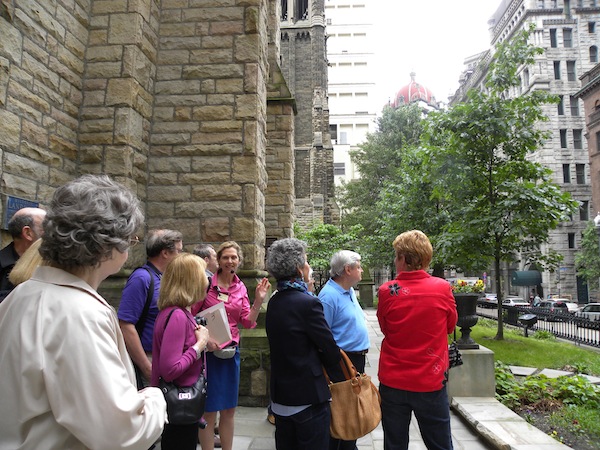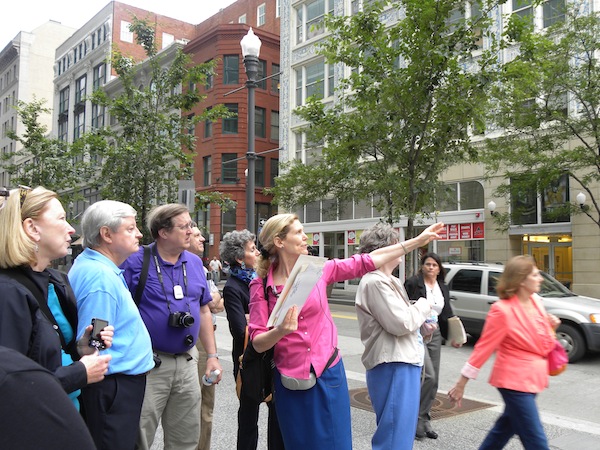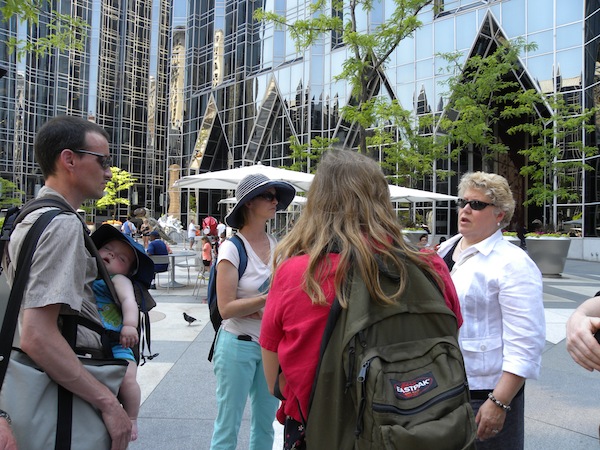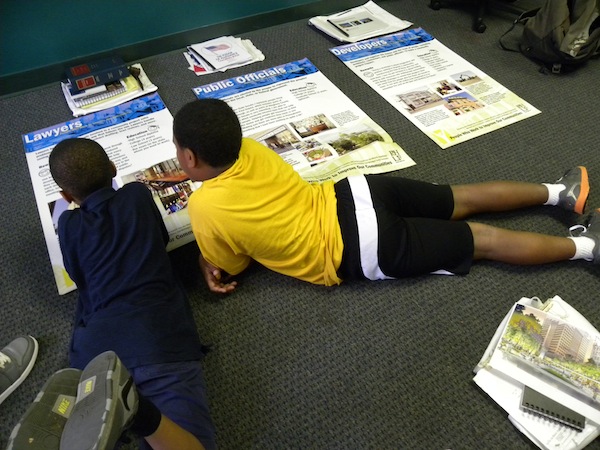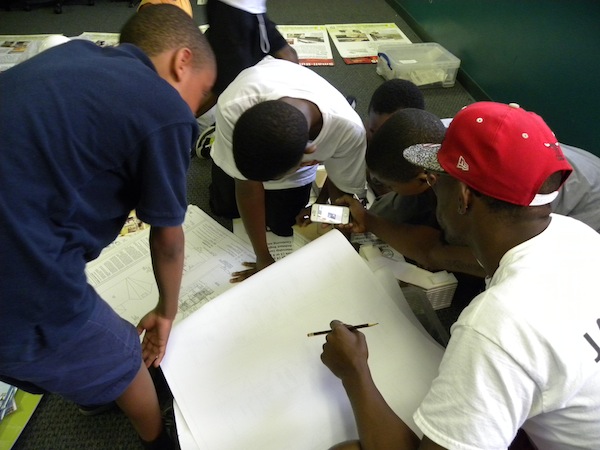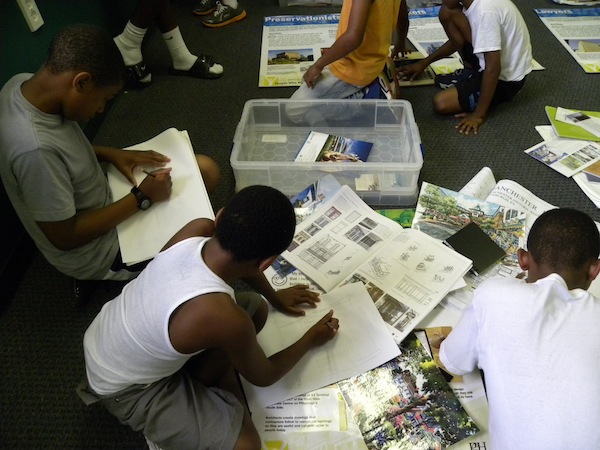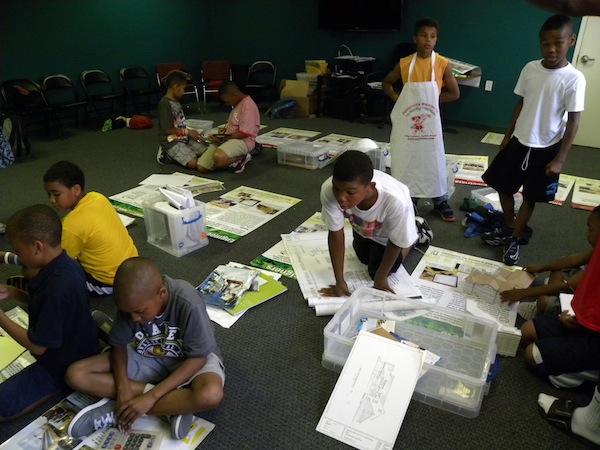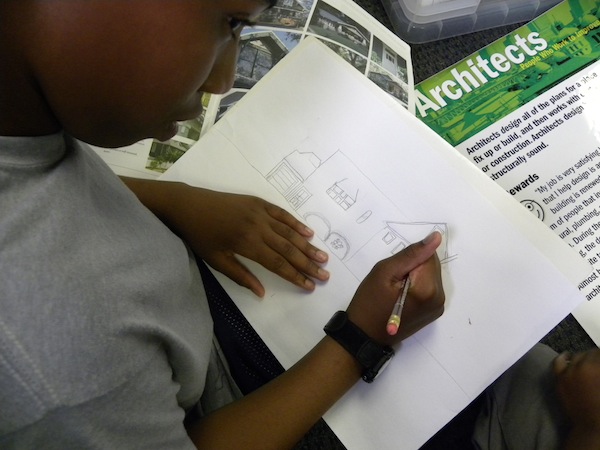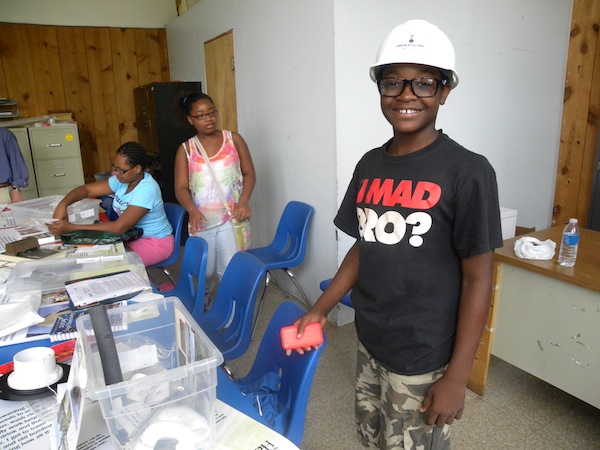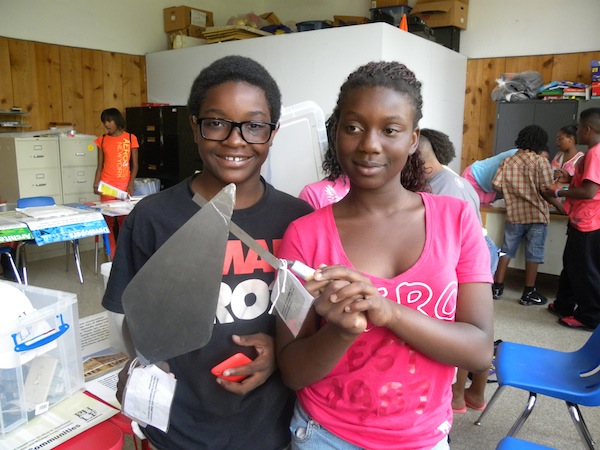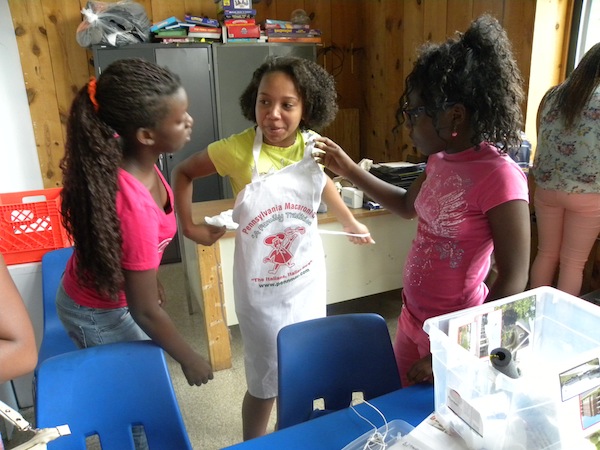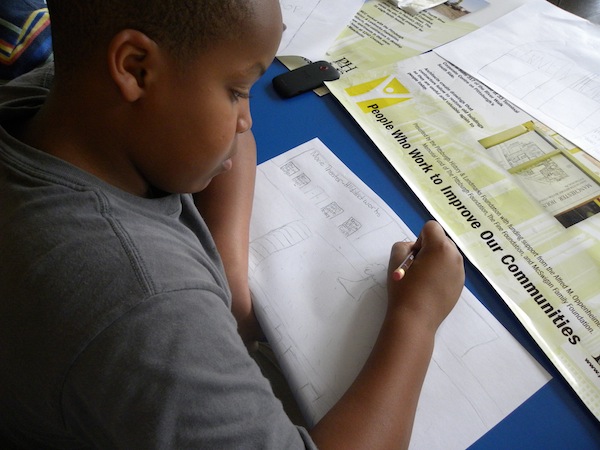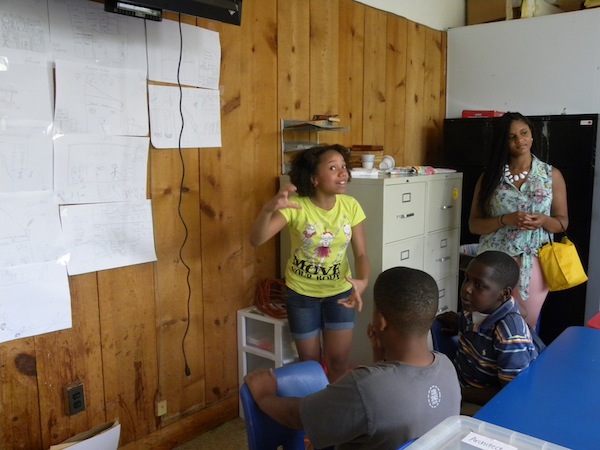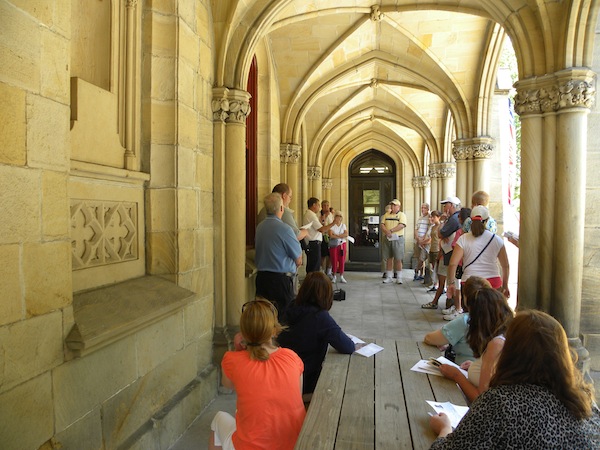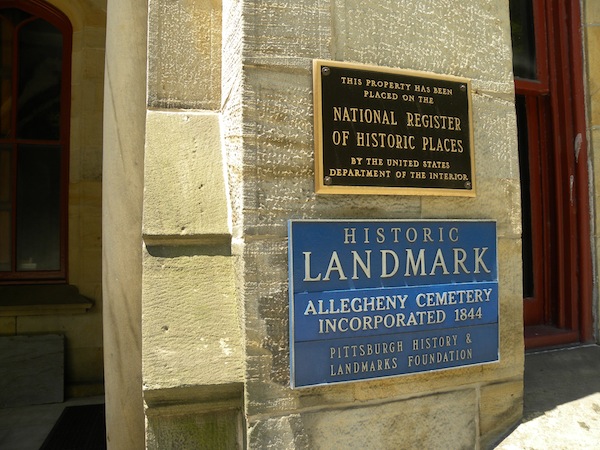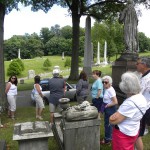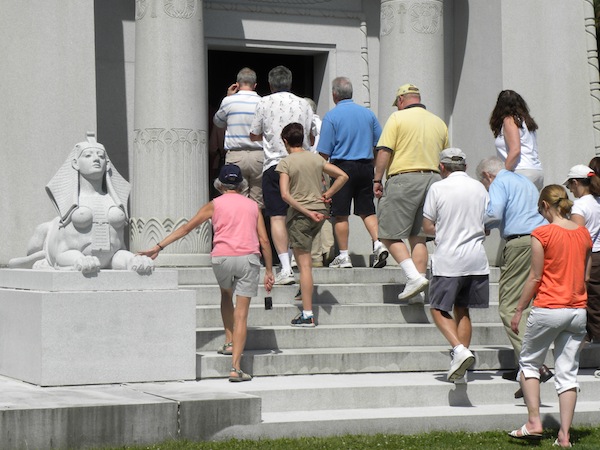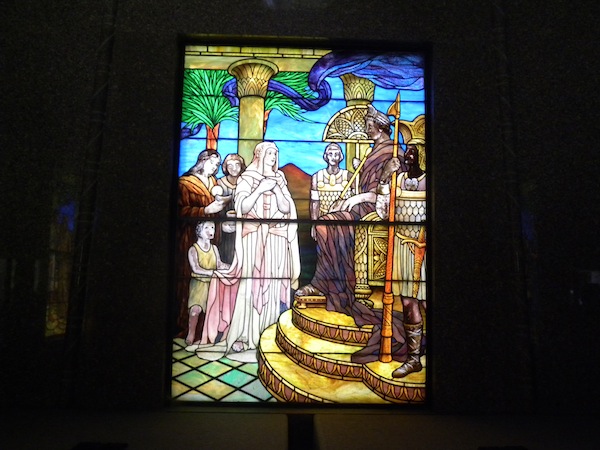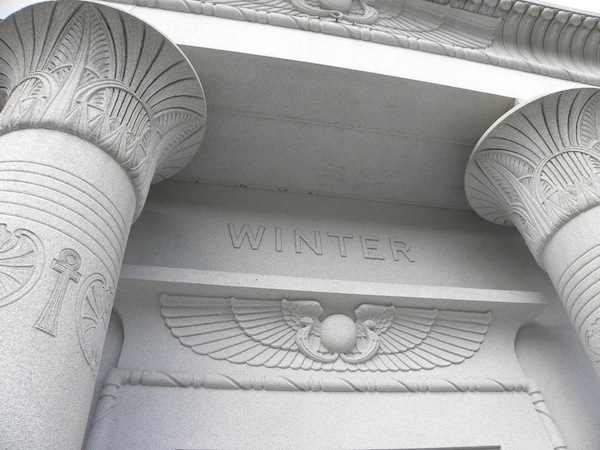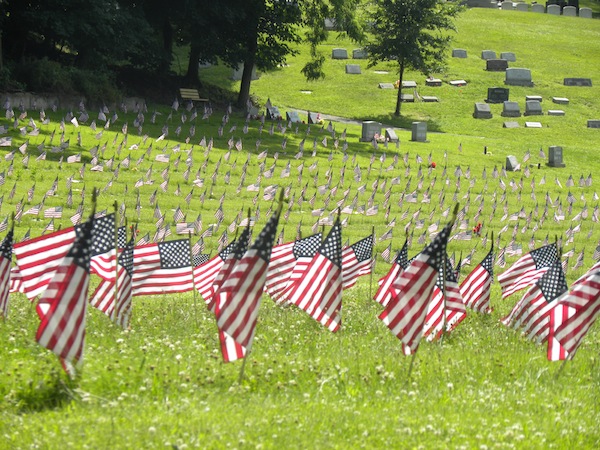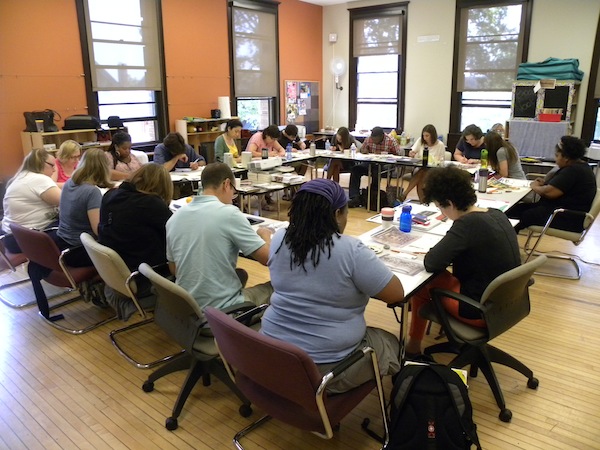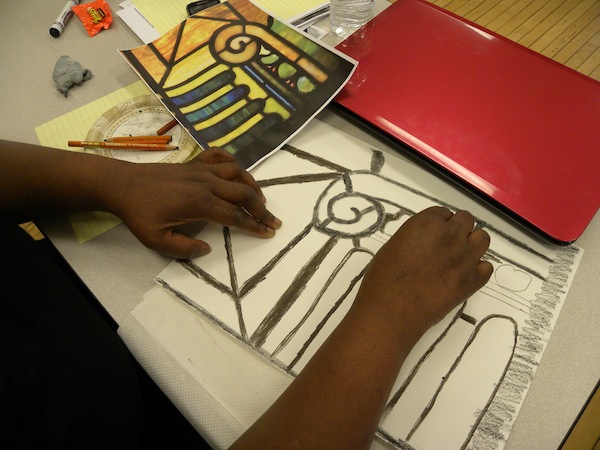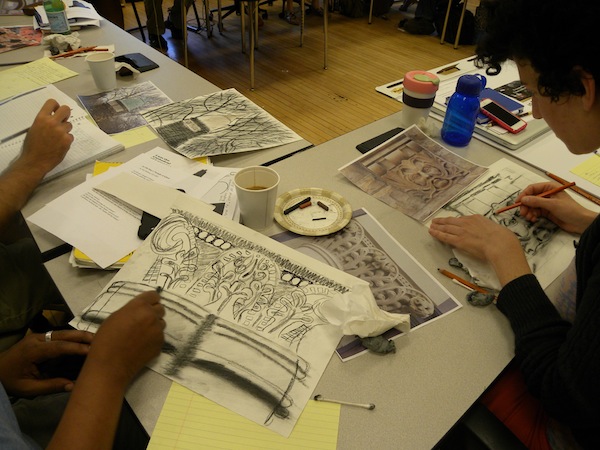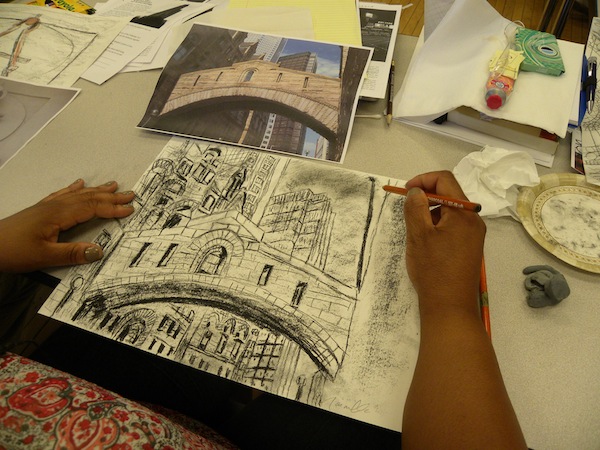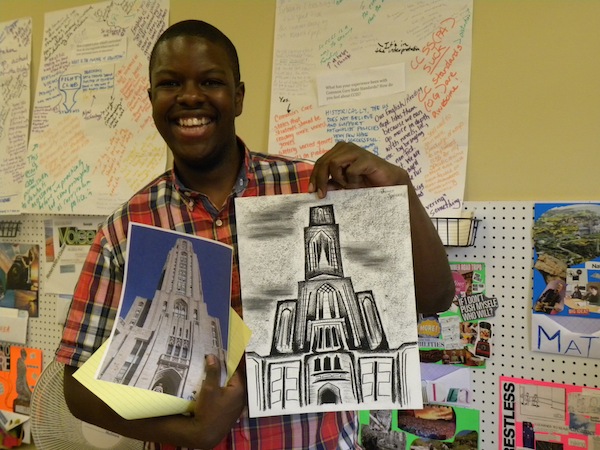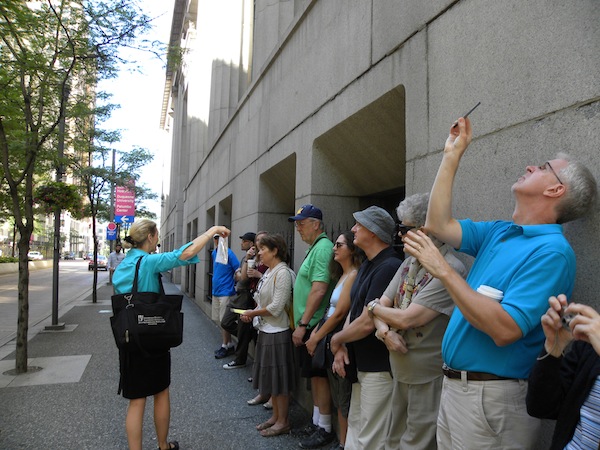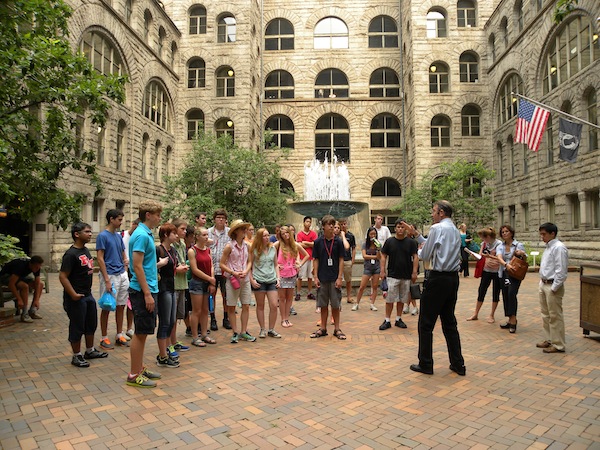
Category Archive: PHLF News
-
Xperience Zone Tours with PHLF Aboard Molly’s Trolleys
Thanks to funding from the McSwigan Family Foundation and Alfred M. Oppenheimer Memorial Fund of The Pittsburgh Foundation, PHLF was able to underwrite a full-day trolley tour on August 8, 2013 for middle and high school students and counselors in the Blakey Program Center’s Xperience Zone summer camp, administered by the Hill House Association.
At Carnegie Mellon University, students were inspired by Doug Cooper’s 200-foot-long mural of Pittsburgh, Kraus Campo, the College of Fine Arts, Randy Pausch Memorial Bridge, and “Walking to the Sky” sculpture. After lunch, students rode up and down the Duquesne Incline and visited Point State Park. As the trolley headed back to the Hill, a special stop was added so everyone could read the PHMC marker downtown on Third Avenue honoring Martin Delaney (1812-1885), the father of Black Nationalism.
Campers and counselors from the Xperience Zone, ages 10 to 18, wrote the following about their experiences:
- This was a fun experience for us because other middle school children do not get the chance to explore a campus. My favorite place was the Duquesne Incline. What I think is that my city is a great learning experience. I am very glad I live in this city because there are many things that I didn’t know about Pittsburgh. I would like to go to Carnegie Mellon University. Thank you! ––Antonae
- I want to state that the people who are responsible for this trip are incredible and blessed ones. This experience was great beyond measure. I have no favorite site since they all were amazing. I learned that 36 years before being elected, our first President of the United States, George Washington, was a big part of founding Pittsburgh. Native Americans actually lived and hunted in this region. Pittsburgh, our city, was named after William Pitt the Elder, the British statesman who made sure that General Forbes had enough troops, artillery, and food to win the French and Indian War. I also never knew about architectural styles like medieval and gothic that were shown in niches at Carnegie Mellon University. My tour guide gave me a diagram of the architectural niches at the College of Fine Arts, which was tremendously appreciated. Thanks! ––Edward Murphy
- I liked the “Walking to the Sky” sculpture because it was peaceful to me when we were looking and talking about the sculpture. I also liked the fountain at Point State Park because it was also peaceful and we got to walk around the water. I also saw a rainbow that was really pretty. That’s why I liked the tour of Pittsburgh. ––Rashai Humphrey
- I wanted to tell the Pittsburgh History & Landmarks Foundation about my trip today. It was a great trip. I learned a lot more about Pittsburgh. I want to tell you some stuff about the places. The Block House was a great place. I learned things about what happened 249 years ago. At Carnegie Mellon University, Doug Cooper’s drawings were really great. I really like all the drawings he drew of the City of Pittsburgh. I learned more about Oakland. ––Kayla Kinney
- I have learned a lot of new and interesting things about Pittsburgh, such as the oldest building in Pittsburgh is the Block House and the tallest building is U.S. Steel Tower (with the letters UPMC). I also got to see Carnegie Mellon University up close and I learned to appreciate it for its history and education. I thank you guys for the trip that I will never forget. Also our tour guide was great! ––Taylor A. LeSesne-Jones
- Thank you for allowing us to take this trip. I really liked it. I liked the Block House and the Fort Pitt Museum. I learned that it once was just a fort and a couple of buildings. I live in Atlanta and I hate it. Pittsburgh is better than Atlanta. I wished I lived in Pittsburgh. I hope to attend the University of North Carolina. If I had to choose a favorite site, it would be the Block House. ––Eric Poulson
- I would love to go to Carnegie Mellon University, but the tuition isn’t cheap. I could pass up living life with a ton of student debt. I remember someone describing Pittsburgh as a “city-not-city.” That’s exactly how I would describe it. I wouldn’t want to grow up anywhere else. I would rather work at CMU because it combines arts and science education. The campus is absolutely beautiful. A suggestion for the tour would be a more thorough knowledge of the museum exhibits. There was a moment or two when questions were answered with “I don’t know.” ––Tyra Jamison
- The Duquesne Incline was my favorite place. I had fun because going up, at first, was kind of scary. When going down, it wasn’t scary at all. ––Nicole
- The Duquesne Incline machinery room was my favorite place. I learned a lot about how the incline worked. At first I didn’t feel safe, but now I do because I saw how it worked. The mural of Pittsburgh by Doug Cooper was very interesting because I didn’t know anything about Pittsburgh and it told us about our history. ––Alycia
- Thank you for the experience, though it would have been nice to learn about Native Americans because they were here first. One of my favorite parts was walking through Carnegie Mellon University. It was nice to get a little tour. It was really interesting to see how exactly the Duquesne Incline works. When we came to the Fort Pitt Museum the people who worked there didn’t know what some of the symbols stood for in William Pitt’s coat of arms, but other than those two things the trip was cool and insightful. ––Etana Laing
- My favorite place was the Duquesne Incline because I loved the beautiful view. ––Adia Russell
- I would like to thank the people who made this possible for me to go to all the places I went today. I really liked the Duquesne Incline. I also liked the Carnegie Mellon University tour. It was great because I am in middle school getting tips about a college. I wish my school had the opportunities that we had at the Experience Zone. ––Payton Bell
- I liked when we went to the College of Fine Arts at Carnegie Mellon University. I would like to go there. I loved the “Walking to the Sky” sculpture that tells you where you want to go in the future. Also, the Fort Pitt Block House tells about the British soldiers. ––Amontae
- I learned a lot of different things I didn’t know about plus I learned about things I am interested in. The Fort Pitt Block House and the Fort Pitt Museum were my favorites. Pittsburgh was named after William Pitt who never came to Pittsburgh. He was in England so I find it unjust. The tour was great. I realized there are a lot of things I still haven’t seen or experienced yet. ––Amaru Williams
- I just want to take the time and tell the people who made the trip possible for our kids thank you! I really thank you for putting this trip together to give our kids the knowledge of teaching them new things and not only them, but me as well. It opened up my mind to a lot of new things. ––Ms. Jasmine Lawton
- The things we did today were explore some of Carnegie Mellon University. I also learned something about the college and sculptures. We went on the Duquesne Incline and saw a view of Pittsburgh and learned how the machinery works. We went to Point State Park. My favorite place was the Point because of the water fountain. ––Marua
- I would like to tell the people who made this trip possible for us thank you very much and that I appreciate what they did. My first favorite place was Carnegie Mellon University and I would like to go there. My second favorite place was going on the Duquesne Incline. Even though I was scared I still got on it. I think my city is very beautiful and big. I never really liked my city but now that I learned a lot about it I really enjoy my city. ––Tyraa Gilliam
- I liked the Duquesne Incline observation deck because I got to see a view of my hometown Pittsburgh. I am glad that I live in Pittsburgh. I think that our city is amazing. We have a lot of people who see why Pittsburgh is such a beautiful city. I don’t know why people don’t want to come to Pittsburgh and learn about all that has happened to Pittsburgh. ––Nyjae Mitchell
- I want to tell the people who made this trip possible that I had an amazing time. This trip gave me more history that I didn’t know about the City of Pittsburgh. My favorite place was the Duquesne Incline. The new facts that I learned about Pittsburgh are that there are plenty of sites that dealt with revolutions and woman’s rights. I think the City of Pittsburgh deals with a lot of American history. I am very glad I live in this city because it never runs out of things to learn about. ––Joshalyn Copeland
-
Comments from 2013 Tour Participants
I work in town for Dollar Bank. I have been on two lunch-hour tours and have so completely enjoyed them. I have lived in Pittsburgh for 62 years and found out so many new and interesting things about our city through the tours. The guides are so informative and nice. I can’t wait for the next one. What a wonderful way to spend one’s lunch hour. Thank you to all the volunteers and people who put these great programs together for the public to enjoy. ––Bonnie Kisty, July 30, 2013
What a fantastic experience for us lifelong city residents to come into downtown and appreciate how lively Market Square is during the afternoon! Our tour guide was organized, efficient, friendly, familiar with all the information about Market Square and the surrounding development. I have recommended the tours to friends and hope to attend the Grant Street tour in the future. I am encouraged to come into town to enjoy the amenities during the day. I also walked over to see the Knit the Bridge and our guide took us to the Legacy Building following the tour and encouraged us to see the artifacts in the Fairmont which I already have seen. The tour helped us appreciate why people would want to live downtown. The brochure we were given is a great source of information. Thank you!––Warren Coax, August 22, 2013
The tour today was great. . . . The guide was so enthusiastic. She makes the tour so much fun. We learned so much. We saw things that we never noticed before. The tour was not too long, although I was getting a little tired, but she made it so interesting we didn’t want to end. I don’t think there is anything you can do to improve your “Downtown’s Best” two-hour tour. ––Gary J. George, August 26, 2013
-
City Main Streets & More––Free Walking Tours
All tours are offered in cooperation with the Urban Redevelopment Authority of Pittsburgh and are limited to 25 participants. Karen Cahall from PHLF and neighborhood representatives will lead the tours.
Reservations required. Contact: Mary Lu Denny (412-471-5808, ext. 527)
Sat., Sept. 7 (2:00 to 3:30 p.m.): South Side––From River to Rail
Sat., Sept. 21 (2:00 to 3:30 p.m.): Hill District––Centre and Wylie Avenues
Fri., Oct. 4 (Noon to 1:00 p.m.): Mt. Washington––Shiloh Street Area
Fri., Oct. 11 (Noon to 1:00 p.m.): Brookline––Brookline Boulevard
Fri., Oct. 18 (Noon to 1:00 p.m.): Brighton Heights––California Avenue
Fri., Oct. 25 (Noon to 1:00 p.m.): Northside––Federal Street Area
Further details are as follows:
Saturday, September 7, 2013
South Side––From River to Rail
Explore South Side from a new perspective as we walk along 18th Street, from the Three Rivers Heritage Trail along the Monongahela River to the railroad tracks and the steps going up the South Side Slopes. Hear the story of how the Flats and Slopes developed. See the new housing development along the river and hear how South Side is balancing the needs of businesses and residents while working to keep this historic neighborhood vibrant.
Meeting time & location: 1:45 p.m., 1720 South Shore Court, 15203
Saturday, September 21, 2013
Hill District––Centre and Wylie Avenues
From the long-awaited grocery store now under construction to the Thelma Lovette Family YMCA on Centre Avenue, improvements are in progress along Centre and Wylie avenues. Learn what else is in the works for this area of the city where so many immigrants once settled and where jazz greats and Pulitzer-prize winning playwright August Wilson found inspiration.
Meeting time & location: 1:45 p.m., Freedom Corner (91 Crawford Street, 15219)
Friday, October 4, 2013
Mt. Washington––Shiloh Street Area
The Mt. Washington neighborhood along Shiloh Street has so much to offer: the Shiloh Inn, Redbeard’s, and more recently opened businesses including the Grandview Bakery & Sweet Shop, the Micro Diner, and Havana’s Tapas & Wine Bar. After touring the historic business district, we will learn how to access Emerald View Park that circles Mt. Washington.
Meeting time & location: 11:55 a.m., Parklet on the corner of Grandview Avenue and Shiloh Street, across from the Monongahela Incline Observation Deck, 15211
Friday, October 11, 2013
Brookline––Brookline Boulevard
Through a URA Renaissance Grant, Brookline is undergoing a major renovation with new traffic patterns and parking to better serve the thriving business district. We’ll explore this neighborhood in the midst of change and tour several of the businesses.
Meeting time & location: 11:55 a.m., 933 Brookline Boulevard, 15226 (at the corner of Glenam Avenue near St. Mark Evangelical Lutheran Church)
Friday, October 18, 2013
Brighton Heights––California Avenue
This short walk along California Avenue will show off the longest continuously operating business on this street and the newest business, while we learn the story of how this neighborhood came to be and what challenges it is facing today.
Meeting time & location: 11:55 a.m., 3689 California Avenue, 15212 (at Termon Avenue, outside Adam Ravenstahl’s office)
Friday, October 25, 2013
Northside––Federal Street Area
First we will visit the Allegheny City Room in the Carnegie Library of Pittsburgh––Allegheny––to see historic photographs of the area. As we walk from Federal Street and North Avenue into the Allegheny Commons, we will hear how this corridor of central Northside is being revitalized through URA projects, including the Garden Theater development.
Meeting time & location: 11:55 a.m., 1230 Federal Street, 15212 (outside the Carnegie Library of Pittsburgh––Allegheny)
-
Thank You Summer Interns
PHLF staff thanks Katelyn Schoenike (College of Wooster, archaeology), Luis Espinoza-Delgado (Harvard University, economics), and Jolene Byford (University of Texas, architecture and architectural engineering) for their volunteer assistance this summer. They assisted with educational programs, tours, and publications, among many other activities. The following comments from the interns summarize their experiences:
- My internship at PHLF has been full of many experiences that have taught me to not only appreciate the City of Pittsburgh for its great history and evolution but has also emphasized the importance of preserving and reusing the history within the city. As a future archaeologist studying at the College of Wooster, I focus on recreating history from ruins and destruction. PHLF has expanded this thought process to have a larger meaning by not only recreating the ruins, but also preserving the history that currently stands before us. This lesson has only given my passion greater meaning and importance that I will carry with me throughout my career. ––Katelyn Schoenike
- I am very fortunate to have worked with PHLF. This organization has not only stimulated a greater personal awareness of Pittsburgh’s rich history and sharpened my research skills in archival and real estate work, but it has also ingrained in me a message that drives PHLF’s efforts—preservation creates a better quality of life for all. ––Luis Espinoza-Delgado
- My internship this summer has been a great experience. I’ve really enjoyed helping with the tours and watching both children and adults express a desire to learn about Pittsburgh’s wonderful history. It has also been fun helping with the high school programs I was once involved in. I hope I am able to spark the interest of more students in architecture and preservation. I have loved those subjects since a very young age. ––Jolene Byford
-
PHLF to Publish New Guidebook
This December, PHLF will publish the fifth in a series of guidebooks, thanks to a lead grant from the Sports & Exhibition Authority of Pittsburgh and Allegheny County and donations from members and friends.
Pittsburgh Architecture in the Twentieth Century: Notable Modern Buildings and Their Architects, by Albert M. Tannler, will be the first guidebook devoted solely to twentieth-century buildings in metropolitan Pittsburgh. The 296-page book will be illustrated with more than 300 color photos.
The introductory chapters explore the appearance and diverse meanings of “modern architecture” in the United States and document the arrival of modern design in Pittsburgh from the turn of the twentieth century through the post-World War II period, culminating in the completion of Point State Park. After an introduction to the language of architecture, the Guide presents a selection of 53 extant buildings and structures that embody aspects of twentieth-century architectural practice from 1903 to 1999. Some thirty additional structures are presented in three thematic sidebars. Many of the buildings and structures in the book have either been designated as local, state, and national landmarks or qualify for future designation. Some are endangered; others have been adapted to new uses. Extensive notes, a bibliography, and an index are provided.
Click here for a listing of other books published by PHLF.
-
Businesses Can Give Now to PHLF through EITC Program
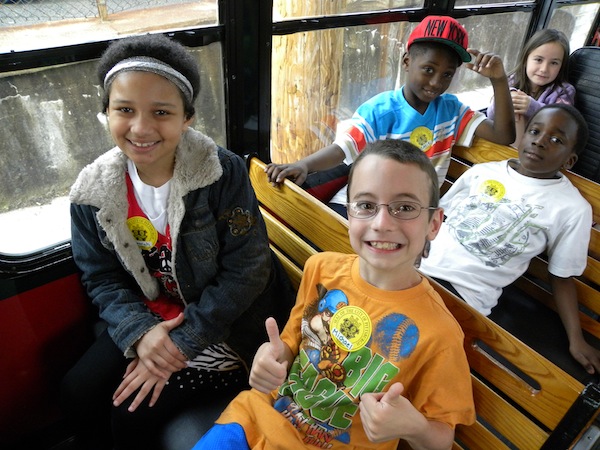 The Commonwealth of PA has listed PHLF as an approved “Educational Improvement Organization” for the current 2013-14 fiscal year. By donating to PHLF, businesses who meet certain criteria will receive tax credits equal to 75% of their contribution for one year or 90% of their contribution if the business agrees to provide the same amount for two consecutive tax years.
The Commonwealth of PA has listed PHLF as an approved “Educational Improvement Organization” for the current 2013-14 fiscal year. By donating to PHLF, businesses who meet certain criteria will receive tax credits equal to 75% of their contribution for one year or 90% of their contribution if the business agrees to provide the same amount for two consecutive tax years.We thank Huntington Bank, PNC Bank, BNY Mellon, and Maher Duessel, CPA, for recently contributing to PHLF through the EITC program. To support PHLF’s “Building Pride/Building Character” EITC program for the Pittsburgh Public Schools, please visit the EITC website and complete the application (Appendix I EIO) found in the “EITC Business Guidelines.”
The words of one grateful teacher reflect the words of more than 1,300 students, teachers, and parents: “Please keep funding. Your dollars really help to educate. I have been on several field trips sponsored by your dollars and they have been the most interesting and educational. Thank you!”
PHLF’s “Building Pride/Building Character” program for 12 Pittsburgh Public Schools in 2012-13 consisted of 25 field trips, 7 in-school presentations, publishing projects (resulting in the publication of 4 books featuring student writing and artwork), art activities (resulting in the creation of 7 stained glass windows and 3 murals), and participation in a live radio broadcast. Student and teacher comments included the following:
- A big Thank You to ALL of the businesses that continuously support your effort in educating our youth with programs such as this one. Without them, this program could not continue.
- One Colfax student said: “This is such a great day I forgot we were on a field trip.”
- Another Colfax student added with tremendous enthusiasm: “This is the best field trip ever.”
-
Fairbanks Feature: Keeping on the “Right Track”
James D. Van Trump Library | Frank B. Fairbanks Transportation Archive | Fairbanks Features
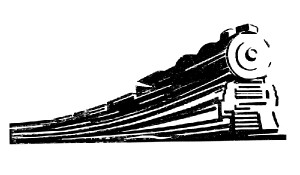 Showcasing a variety of materials located in the Frank B. Fairbanks Rail Transportation Archive
Showcasing a variety of materials located in the Frank B. Fairbanks Rail Transportation ArchiveNo. 18 Presentation
Fairbanks Feature: Keeping on the “Right Track”
For the researcher, track layout diagrams and charts can be a vital source of information. The importance of yard facilities for repair and maintenance needs, for work being done for local businesses, and for the larger concerns because of being a hub, are all reflected in track lanes, spur needs, and turnarounds. As passenger train travel diminished, many of these once-thriving work areas lost their importance, and, in some cases, ceased to be altogether.
The Frank B. Fairbanks Rail Transportation Archive has hundreds of track layout diagrams. Most of these diagrams are from locations in the United States, but there are a few from Europe and South America. The diagrams run from 8 ½ x 11 inches on sheets of paper that have been copied from sections of larger layouts, to original full-length track layouts and charts as long as 94 inches, with every kind of presentation in between. Some of the original track layout diagrams are such stunning works of industrial art that they could be framed and enjoyed by even the casual viewer. Professionals drew these track layouts, and even the “copies from copies” show grace and movement on flat surfaces.
Recently, Mr. Wayne A. Cole donated the materials he gathered for the writing and publication of Ghost Rails V and Ghost Rails VIII. Among the hundreds of pages of materials (all available for the enjoyment of visitors to the Archive) are countless track layouts used by Mr. Cole in writing about the old rail lines of the Northern Sub and the PRR Butler Branch, Kiski Junction and Winfield RR. Some are copies, but there are originals in these materials also.
Mr. Christopher Milne has donated a great deal of material on the Conway Yard, with great track layouts. He has also donated a vast source of Norfolk Southern material, including many track charts and diagrams as recent as 2007 and of the local area.
Most of the Archive track layouts are from the 1920s through the 1950s, resulting in good information for the researcher at the time when trains were especially important in our country. The following materials are shown in the photos below:
- Conway Yard
- West Tarentum Yard; Millvale, Etna, Sharpsburg; Ellsworth; Norfolk Southern Pittsburgh Division––Federal Street
- Track Charts in the United States other than in this immediate area:
––Norfolk and Western Railway, Norton-St.Paul-Bristol-Roanoke, 1985
––Lang York-Toledo, 1985
––Kansas City-Terminal Railway and other rail yards
––Baltimore and Ohio––Green Springs to Petersburg
––Baltimore & Ohio Railroad, tracks, yards––Hazelton Crossing to McDonald
Mills, Ohio, 1910
- Penn Central Pittsburgh Division––Panhandle, 1971
––PRR-Central Region-Pittsburgh 1948, Track layout between 11th St. and 51st St.
––Pitcairn Yard, Fortune Magazine, May 1936
- Butler Branch
––Yard layout with turntable and other buildings
––B&O Central Region Pittsburgh Division––Butler to Mt. Jewett, 1931
The Frank B. Fairbanks Rail Transportation Archive is open by appointment on Mondays, from 10:00 a.m. to 5:00 p.m. Use of the archive is free to PHLF members (one of the benefits!); non-members are assessed a $10 use fee.
The Archive is located on the fourth floor of The Landmarks Building at Station Square, in the offices of the Pittsburgh History & Landmarks Foundation.
To schedule an appointment, email the Librarian James Halttunen: James@phlf.org
-
Summer’s Best: Tours, Career Awareness, and Workshops
PHLF’s education staff and docents are busy presenting PHLF’s award-winning career awareness program, leading tours most days of the week, and participating in workshops for teachers. Grants from the Alfred M. Oppenheimer Memorial Fund of The Pittsburgh Foundation, The Fine Foundation, and McSwigan Family Foundation help underwrite our educational programs. See the photo gallery below for highlights of our recent programs.

